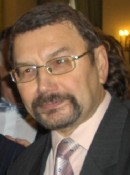
Plenary Lecture
Image Processing and Recognition for Human Identification. Biometrics and Forensic Applications

Professor Ryszard S. Choraś
Institute of Telecommunications
Department of Telecommunications and Electrical Engineering
University of Technology and Life Sciences
Bydgoszcz
POLAND
E-mail: choras@utp.edu.pl
Abstract: This lecture is a survey on biometrics and forensics, especially methods of image processing and recognition for human identification. A biometric system is a pattern recognition system that recognizes a person on the basis of a feature vector derived from a specific physiological or behavioral characteristic that the person possesses.
All biometric systems work in a similar fashion:
-The user submits a sample that is an identifiable, unprocessed image or recording of the physiological or behavioral biometric via an acquisition device,
-This image and/or biometric is processed to extract information about distinctive features.
Biometric systems have four main components: sensor, feature extraction, biometric database, matching-score and decision-making modules. The input subsystem consists of a special sensor needed to acquire the biometric signal. Invariant features are extracted from the signal for representation purposes in the feature extraction subsystem. During the enrollment process, a representation (called template) of the biometrics in terms of these features is stored in the system. The matching subsystem accepts query and reference templates and returns the degree of match or mismatch as a score , i.e., a similarity measure. A final decision step compares the score to a decision threshold to deem the comparison a match or non-match.
The processes of forensic computing can be divided into three main areas:
-Image Capture - The Imaging process is fundamental to any computer investigation.
-Image Processing - The processing software to extract features of the target image.
-Investigation.
Distinctions between biometrics and forensic are based on the fact that biometrics methods are implemented on live subjects. Techniques designed for person identification in biometrics can be utilized for forensic purposes.
Automated biometrics-based personal identification systems can be classified into two main categories: identification and verification.
The personal attributes used in a biometric identification system can be physiological, such as facial features, fingerprints, iris, retinal scans, hand and finger geometry; or behavioral, the traits idiosyncratic of the individual, such as voice print, gait, signature, and keystroking.
In this paper a recognition methods are presented for recognizing a person on the basis of a feature vector derived from a biometrics templates/images.
Brief Biography of the Speaker: Prof. Ryszard S. Choraś is currently Full Professor in the Institute of Telecommunications of the University of Technology & Life Sciences,Bydgoszcz, Poland. His research experience covers image processing and analysis, image coding, feature extraction and computer vision.
At present, he is working in the field of image retrieval and indexing, mainly in low- and high-level features extraction and knowledge extraction in CBIR systems. He is the author of Computer Vision. Methods of Image Interpretation and Identification (2005) and more than 163 articles in journals and conference proceedings.
He is the member of the Polish Cybernetical Society, Polish Neural Networks Society, IASTED, and the Polish Image Processing Association. Professor Choras is a member of the editorial boards of MachineVision and Graphics, International Journal of Biometrics (IJBM), International Journal of Biology and Biomedical Engineering, Recent Patents On Signal Processing (Bentham Open). He is the editor-in-chief ofWSEAS Transaction on Signal Processing Journal, Image Processing and Communications, An International Journalandassociate editor-in-chief Computer Science Journals (CSC Journals) Image Processing (IJIP).
He is also the chairman of the Image Processing and Communications Conference (2009, 2010, 2011, 2012, 2013) and editor books Image Processing and Communications Challenges published in Advanes in Intelligent Systems and Computing Springer Verlag Series.
He has served on numerous conference committees, e.g., as Visualization, Imaging, and Image Processing (VIIP) , IASTED International Conference on Signal Processing, Pattern Recognition and Applications (SPPRA) and International Conference on Computer Vision and Graphics in Warsaw, ICINCO\ICATE Conference.